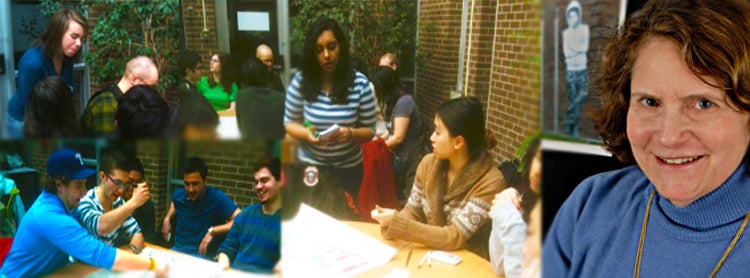 |
| Laura Johnson, along with students from her PLAN 233 course (People and Plans). |
Written by Sophie Twardus, Special Projects (Teaching Stories), CTE.
Helping students transfer knowledge gained in the classroom to the contemporary workplace is a challenge faced by many instructors. Too often university courses are taught in a vacuum, with content estranged from its real-world application. This challenge is especially acute in a domain like urban planning where workplace decisions can be shaped by input from a wide variety of third-party interest groups. The question is how to help students experience those "messy" real world scenarios.
Enter Dr. Laura Johnson, an instructor in Waterloo’s School of Planning for fifteen years. Johnson strives to bridge the gap between the classroom and the real world by providing her students with case studies, organizing field trips to innovative planning sites, and inviting planning professionals as guest speakers. Additionally, to provoke thinking about some of the choices that planners face, Johnson has her students in PLAN 233 (People and Plans) participate in a “charrette” – that is, an intensive design workshop in which participants are presented with a specific design problem, and then work toward a solution under a tight deadline.
In the charrette, Johnson’s 90 students were presented with a scenario pertaining to the redevelopment of an imaginary waterfront neighbourhood in a community located west of downtown Toronto. Students were asked to join one of six interest groups including developers, tenants, homeowners, local business interests, local landlords and environmentalists. The groups were asked to develop proposals which were presented to half a dozen planners (also role-played by students) in a plenary meeting.
The charrette was an excellent simulation of urban planning. The exercise allowed students to better empathize with the perspectives of developers, conservationists, and residents. It exposed the students to a situation that is time-sensitive, team-oriented, and requires precise articulation of their point of view to an audience that is not necessarily sympathetic to it. Overall, the charrette exercise was intended to teach students to consider and evaluate multiple perspectives in answering tough urban planning problems.
The reaction to Johnson’s efforts to enrich her course with the hands-on experience of the charrette was overwhelmingly positive: in course evaluations, students indicated that they enjoyed the charrette experience and learned much about participatory planning through the activity. Cyrus Yan, a Teaching Assistant for the course, also reported that the charrette was "a fresh, new experience for the students and it was clear that they took much more away by participating in the exercise than they would have had they merely listened to us describe what a charrette was and how it worked."
The design charrette is now an official part of the PLAN 233 curriculum.
Read more Teaching Stories
Tip sheets
CTE has developed more than 100 Teaching Tips. Each one is a succinct document that conveys useful ideas and practical methods for effective teaching. Some of the Teaching Tips that are relevant to the strategies mentioned in this Teaching Story include the following: